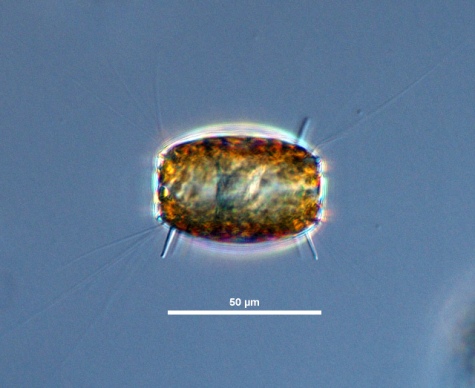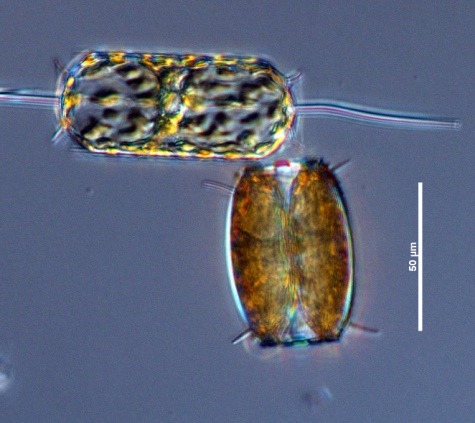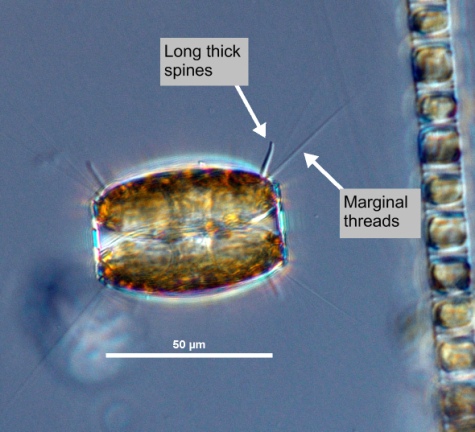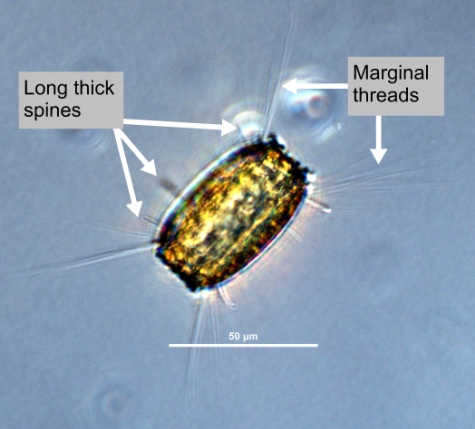



|
Synonym(s)
Heterotypic
A difference in type. In naming species, a heterotypic synonym is one that comes into being when a taxon becomes part of a different taxon. Compare to homotypic.
(heterotypic)Thalassiosira japonica Kisselev 1935 (heterotypic)
Ethmodiscus japonicus Castracane (heterotypic)
Coscinodiscus punctiger (Castracane) H. Peragallo 1889 (homotypic)
Ethmodiscus punctiger Castracane 1886 Close
Basionym
The original name for an organism. In botany, the original published nomenclature from which a new binomial nomenclature is derived for a particular group of organisms (Tindall 1999).
(basionym, CloseHomotypic
Expressing the same fundamental type or structure; may or may not be symmetrical (e.g., the two valves of a diatom, where they are the same shape and appearance, but one is bigger than the other). In naming species, a homotypic synonym is one that comes into being when a taxon gets a new name (without being added to an already existing taxon).
homotypic)(Guiry and Guiry 2012)
Classification
(Guiry and Guiry 2012)
Lifestyle
Description
Valve
In diatoms, the structurally distinct halves of the cell wall (Becker 1996).
valve surface is convex, with distinctive short, thick CloseSpine
In some diatoms, "closed or solid structures projecting from the cell wall;" in dinoflagellates, solid projections that usually taper to a point.
spines CloseOccluded
Blocked.
(occluded CloseProcess
A natural projection or appendage on an organism.
processes) widely distributed around the edge of the valve face (Hasle and Syvertsen 1997). Chloroplasts are numerous and small. The CloseNucleus
(plural: nuclei) In eukaryotic cells, a membrane-bound organelle that contains the cell's genetic information; the nucleus controls the activities of the cell by controlling gene expression.
nucleus is central (Kraberg et al. 2010).Labiate process
In diatoms, a simple slit in the valve wall with two internal lips, one on each side of the slit. They can be useful in identification because they are positioned differently in different species (Horner 2002).
labiate process with external tubes is present near the valve CloseMantle
In diatoms, "the part of a valve that extends from the valve face, forming the valve edge." It is visible when the frustule is viewed in girdle view (Spaulding 2010).
mantle (Horner 2002). There is one central CloseStrutted process
(how is this different than marginal process?) In some diatoms, a narrow tube through the frustule that is usually associated with the secretion of chitin. It may appear as a marginal process or as a simple pore in the valve wall (Spaulding et al. 2010).
strutted process and a ring of small dense strutted processes with short external tubes located close to the CloseRibs
Features that provide support to other structures in the cell.
ribbed valve CloseMargin
The outline or border that defines the shape of an organism or cell.
margin. Valve CloseAreolation
Often used to describe holes (areolae) on the valve surface of diatom frustules.
areolation is in bundles (Hasle and Syvertsen 1997).Measurements
Height: 20 - 120 μm
Valve mantle areolae: 10 - 23 in 10 μm
Close
Marginal process
In some diatoms, a long, coarse external tube through the frustule (Tomas 1997).
Marginal processes: 4 - 5 in 10 μm(Hasle and Syvertsen 1997, Kraberg et al. 2010)
Similar species
Harmful effects
Habitat
Distribution
Cosmopolitan (Kraberg et al. 2010).
Occasionally present throughout the year, but more often during spring and early summer in Northern European seas (Kraberg et al. 2010). More abundant during winter and fall and very scarce in the summer in the European Atlantic (Gómez and Souissi 2010).
Common in low numbers during late spring and fall, rare during the summer.
Growth conditions
Environmental Ranges
Bloom characteristics
References
Cupp, E. E. 1943. Marine Plankton Diatoms of the West Coast of North America. University of California Press. Berkeley, California. 238.
Dürselen, C. D. and Rick, H. J. 1999. Spatial and temporal distribution of two new phytoplankton diatom species in the German Bight in the period 1988 and 1996. Sarsia. 84(5-6): 367-377. Gómez, F. and Souissi, S. 2010. The diatoms Odontella sinensis, Coscinodiscus wailesii and Thalassiosira punctigera in the European Atlantic: Recent introductions or overlooked in the past? Fresenius Environmental Bulletin. 19(8): 1424-1433.
Guiry, M. D. 2011. Thalassiosira punctigera (Castracane) Hasle, 1983. http://www.marinespecies.org/aphia.php?p=taxdetails&id=148936. Accessed 19 Feb 2011.
Guiry, M. D. and Guiry, G. M. 2012. Thalassiosira punctigera (Castracane) Hasle. http://www.algaebase.org/search/species/detail/?species_id=59631. Accessed 19 Feb 2012.
Hasle, G. R. and Syvertsen, E. E. 1997. Marine diatoms. In: Tomas, C. R. (ed.) Identifying Marine Phytoplankton. Academic Press, Inc., San Diego. 5-385.
Kat, M. (1982) Effects of fluctuating salinities on development of Thalassiosira angstii, a diatom not observed before in the Dutch coastal area. J. Mar. Biol. Assoc. UK 62, 483-484. Kraberg, A., Baumann, M. and Durselen, C. D. 2010. Coastal Phytoplankton: Photo Guide for Northern European Seas. Verlag Dr. Friedrich Pfeil, Munchen, Germany. 204.
